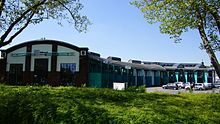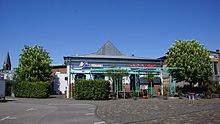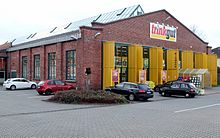Cologne-Frechen-Benzelrath Railway

The Cologne-Frechen-Benzelrath Railway ( KFBE for short ) was a German railway company that operated the Cologne – Frechen railway .
history
In the middle of the 19th century, the western area around the city of Cologne was developed by various railway companies such as the Rheinische Eisenbahn-Gesellschaft , the Bonn-Cölner Eisenbahn-Gesellschaft or the Köln-Krefeld Eisenbahn-Gesellschaft . After the nationalization and integration into the Prussian State Railways , the Prussian Small Railroad Act of 1892 created the possibility of building a network of small railways away from the main lines .

As early as 1891, at the instigation of the traditional pottery industry and the lignite mines and briquette factories ( Sibylla , Wachtberg ...), the Frechen council decided to build a railway line to the Cologne-Ehrenfeld train station and the port in Cologne-Niehl . In order to facilitate the transition to the state railway, the Cologne – Frechen railway line, in contrast to many other small railways, was largely built as a three-rail track in standard gauge for freight traffic and meter gauge for passenger traffic. In 1893 the line was completed and operations started.
In the long run, the maintenance and the need for modernization exceeded the financial possibilities of the small town. In 1904 the municipal own operation was sold together with the line to the city of Cologne, which undertook to undertake extensive expansion measures.
In the following years, the transport volumes increased considerably, measured against this, the KFBE was the second largest private railway in Germany in terms of freight transport in 1934. At that time, lignite accounted for the largest share of freight. In the middle of the 20th century, freight volumes decreased, and new customers such as Esso and Ford were unable to compensate for this.
Due to the increasingly deficit goods traffic, the KFBE was initially integrated as a whole in the Cologne transport company (KVB) ( goods traffic of the KVB ). In 1992 the KFBE split up. Passenger traffic was integrated into the KVB as a tram line and goods traffic was absorbed into the newly established Cologne ports and goods traffic .
Bio's train station
From 1978 to 1982 the program Bio's Bahnhof was broadcast live on ARD from the former depot hall of the Cologne-Frechen-Benzelrath railway .
literature
- Helmut Weingarten: The railway between the Rhine and Erft , contributions on the history of the Erfkreis No. 5, Rhineland-Verlag, Cologne 1978, ISBN 3-79270973-2
- Hafen und Güterverkehr Köln AG (Ed.): 100 Years of Cologne-Frechen-Benzelrather Railway , Cologne, 1993



